Univibing the EH Small-Stone
The Original Phasor-Vibe Mod
'97 (c) JC Maillet
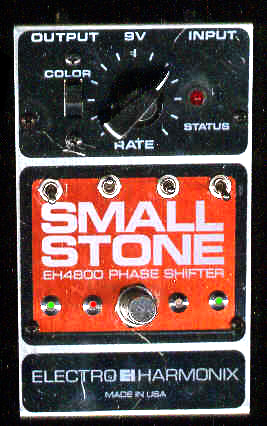 |
Photo 2005 (c) Matteo Pini, Italy
Sometime in the late 70's Rick Onslow - Frank Marino's tech at the time - said to me that you could modify pretty much any four stage phase-shifter to make it sound somewhat like a Univibe ... the key word here is "somewhat" for I haven't set them to lie exactly where a Vibe has them set, rather I'm playing with the 10:1 decade ratio in two parts ... I decided to first try this idea out that concept on the Small-Stone OTA-based circuitry though I've more recently done it on Op-amp based circuits, and those are matched to the Vibe response ... recall that well-behaved "studio" phase shifters have their all-pass filter stages set to an identical shift frequency by using the same shifter cap value throughout ...
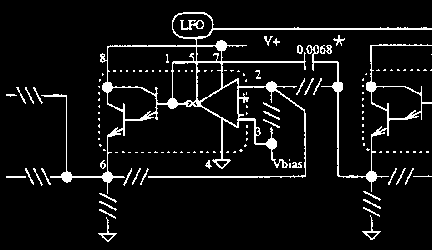 |
In the Univibe each stage doesn't quite provide 90 degrees of shift per stage due to interstage loading and losses, consequently there's AM/VCA action happening in the Univibe signal path because of the non-ideal mixing of anti-phase signals ... this is something you don't see in op-amp and OTA based phasors because of relatively high-input and low-output impedance levels ... aside from this, the shift frequencies are cleaverly staggered in the Univibe, and not in any random manner ... in the Vibe the "magic 4-some" follow near-decade ratios in pairs of two - that is: 15nF, 220nF, 470pF and 4.7nF (15nF is almost 10times less than 220nF, 0.47nF is 10times less than 4.7nF) ... and since the spectral phase shift of the all-pass filters in the Univibe occurs over the typical decade spread it becomes apparent that the Univibe cap ratios suggest that an attempt by the designer(s) to simulates a Low-Hi Leslie Effect by setting the shift frequencies centers together in two pairs, each pair spanning two decades of all-pass phase-shift (phase-frequency response) ... in this mod, aside from maintaining some expression of the Univibe Cap Staggering the Small-Stone receives a little low-end trimming which prevents things sounding too boomy (see my schematic and layout sheet) ...
the Small-Stone, like most phasors, cascades a series of controllable "all-pass" circuits to produce 360 degrees of phase-shifted signal above the all-pass cutoff frequency ... the Small-Stone's buffered ota all-pass circuits have a single capacitor which (partially) sets the phase-crossover frequency ... in virtually every phase shifter out there, except for the Univibe, these caps are set at the same value ... this means that all four stages are shifting signal at the same frequency location ... also, in particular, this means there's 360 degrees of phase shift occuring withing two frequency decades (from Fc/10 to 10*Fc) ... in the Univibe these are staggered so the phase-shifting is spread around in the Frequency spectrum - therefore, you can apply this thinking to same-frequency phasors for a unique alternative to the stock sound ... in the Small Stone I settled on the following alternate values : 1nF, 10nF, 470pF, and 4.7nF - to me this choice reflects the Vibe's pairwise grouping (ordering reflects front-to-back cascading of phase-shift stages) and it turned out sounding great ... each switch can toggle between the original 0.0068uF cap and a new Vibe-math inspired cap (or your own !) ... this produces 15 alternate filter settings for your Small-Stone ...
EH/Sovteck Small-Stone Modification Instructions
After removing the assembly from chassis locate the four green 0.0068uF filter caps (dark green candy) and snip them on the board edge side halfway between solder connection and lead connection to part (or desolder the end - whichever you prefer) ... then solder a 4" wire to each of the four loose capacitor terminal ends ...
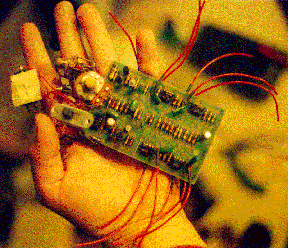 |
... on the back side solder the appropriate/chosen value caps at the same solder point as the uncut terminal of the aforementioned green caps ... run wires also to the solder point where the gree cap used to run to ... x4 ...
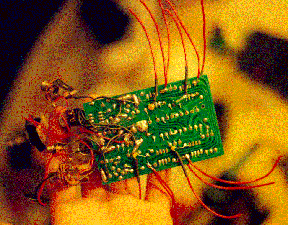 |
... drill holes in the top chassis as shown in the pic so that small switches can be installed around the foot switch and clear all obstacles (a radial distance of one inch from the rim of footswitch hole works good) ... I trim the switch toggles with a dremmel so they don't stick too high ...
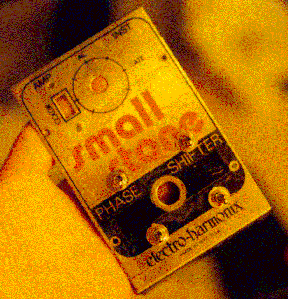 |
I wire the spdt switches with enough slack to twist the wires a half turn so that the stock cap values are switched in when the toggles face down ... I wire the magic caps so that the switches can select original cap in circuit where it used to be and in the other position the magic cap attached directly to the switch ... this is the neatest way of doing it without starting to wreck the board and cutting the original caps completely off the board ...
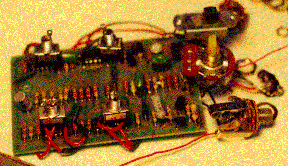 |
With this you've added 15 new sounds to your classic Small Stone ... with all switches flipped up you've got yerself a pseudo-Univibish sound from a small-stone ... I like the setting where the two switches on the bottom are flipped down, the two on top flipped up and the speed switch set on slow ... you get this very wide sweep with lots of top end in it ... in fact, in both deep and shallow modes you get nice usable sounds ...
Russian Stone (c) 2002
Multi-Cap Proto Unit
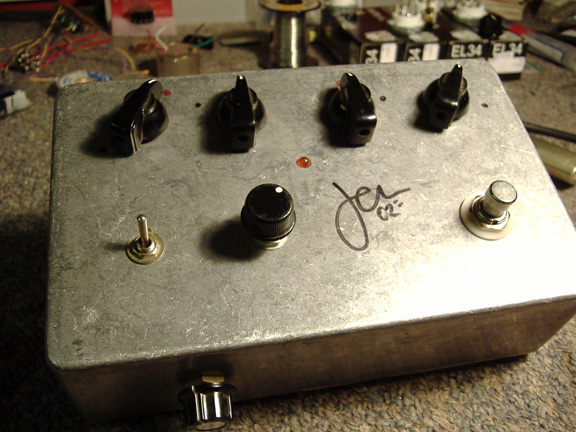 |
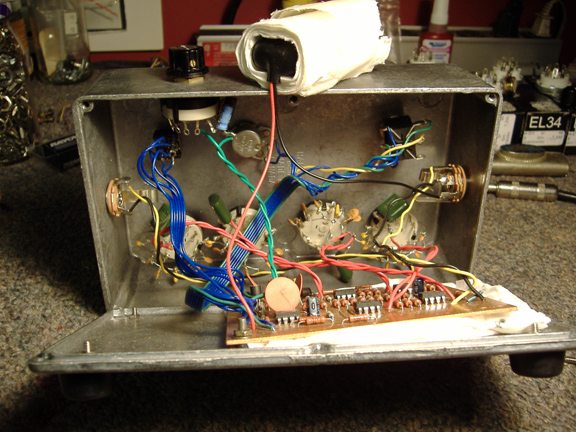 |








